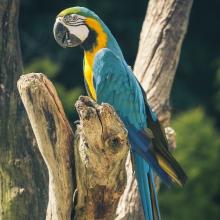Ara ararauna

Conservation Status:
Least Concern on the IUCN Red List (but still a protected species under CITES and other international treaties).
Range:
The northeastern parts of South America.
Habitat:
Wooded areas, usually near water.
Macaws are highly social parrots that form groups of around 20 to 30 birds. Larger groups gather at clay licks on riverbanks. Their beak is adapted for eating seeds and nuts, providing them access to a wide variety of nuts that few other animals can reach. Macaws crack the hard shell between their upper and lower beak, using their tongue and palate to grind seeds for digestion. They consume seeds, fruits, nuts, and some vegetable matter. Macaws have zygodactyl feet (2 toes in front, 2 toes in back), enabling them to grasp onto their food and aiding in climbing. They possess a highly muscular gizzard to assist in the breakdown of extremely tough plant material.
They are excellent flyers, especially over long distances. Their long tail helps them navigate through forests by providing balance.
Blue and Gold Macaws can begin laying eggs around 5 years of age and continue until they are 35. They nest in cavities at the top of tall, dead trees. The female lays one or two eggs, typically a day or two apart. During the incubation period of 24 to 26 days, the male feeds the female and defends the nest site. Once hatched, the young are altricial and rely on parental care for survival. The female regurgitates partially digested vegetable matter to feed the young, and after about a week, the male joins in. By ten weeks, the young macaws have developed feathers, wings, and a tail. Baby macaws have black eyes, but their eye color changes from black to grey to white to yellow as they mature. At six months, distinguishing the young from the parents becomes difficult, except for differences in eye color.
In their natural environment, Blue and Gold Macaws have a lifespan of around 40 years, but under human care, they can live up to 80 to 100 years. Blue and Gold Macaws live well beyond their reproductive years and play a role in teaching the younger birds. Older birds possess knowledge about food acquisition and predator avoidance, which they can pass on to the younger generations.
